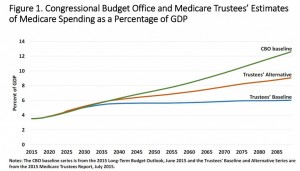What Are We Getting for All That Obamacare Spending?
One reason the United States spends more on health care than other countries is that we are obsessive about health insurance instead of health care. When the British National Health Service or the Canadian Medicare system spends additional money, they spend it employing doctors, building hospitals or buying medical equipment. When the U.S. government spends more money, we give it to insurance companies. Take Obamacare. We are currently spending $214 billion a year insuring people through Medicaid (which is mostly contracted out to private insurers) and the Obamacare exchanges. At $1,731 for every household in America, that’s a great deal of money being transferred from taxpayers to insurance companies every year. What are we getting for all that spending? Are people getting more health care? If they are, what difference is that making?
Nonetheless, one scholarly study finds there has been no overall increase in health care in the US since the enactment of Obamacare. More on that below. The number of doctor visits per capita actually fell over the last decade. That’s surprising, because our population has been aging, and older people require more health care. Unfortunately, there is nothing particularly new here. When Obamacare was enacted, it was expected to cost close to $1 trillion over the next ten years. But there was no serious discussion of what we were going to buy with all that spending – not in Congress, not in the mainstream media, or even in the health policy community.
Our experience with Obamacare is similar to our experience with every major health program Congress has passed or even considered passing. We begin with a claim of unmet needs; we decide on a large sum of money to throw at the problem; but we never ask how the money can meet unmet needs if nothing is done on the supply side. Medicare for the elderly and Medicaid for the poor were huge programs, even when they were started in 1965. In a short period of time the number of people who lacked health insurance dropped from nearly 25 percent to under 15 percent of the population. As a result, physician visits by low-income people increased 6.2% and surgical procedures among the elderly increased 14.7%. But since there was no increase in the ability of the system to supply medical services, these increases were offset by a decrease in care delivered to the non-poor and the non-elderly. A study in the American Journal of Public Health found that “society-wide utilization of medical care remained unchanged.”
Under Obamacare, the number of people without health insurance fell from 15.5 percent of the population in 2010 to 7.9 percent by 2022. Yet the study cited above found that health care utilization across all of society did not increase at all. There was some shifting, as low-income patients got more care, but that care was offset by reductions elsewhere in the system.
When Congress created Medicare Part D to pay for drugs in 2003, it created a $15.6 trillion unfunded liability for the federal government, looking indefinitely into the future. That was more than the unfunded liability in Social Security. Yet economist Andrew Rettenmaier discovered that only 7 percent of the benefits actually bought new drugs for seniors. The other 93 percent simply transferred to government (and therefore to taxpayers) the bill for drugs the elderly or their insurers were already buying. Only one in every thirteen dollars represented a new drug purchase.
More From Goodman Institute:





















